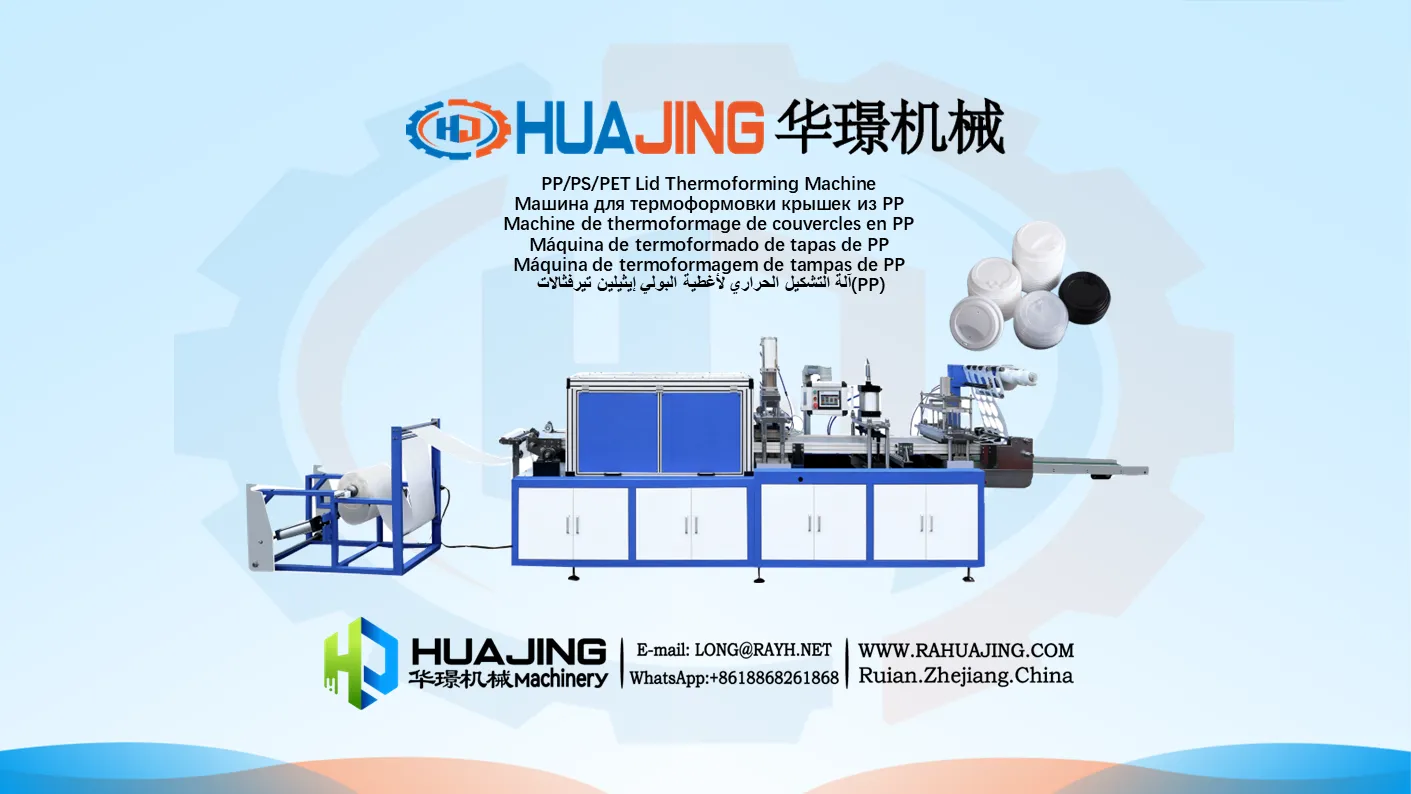
This is a specialized automated equipment used for producing various plastic cup lids (such as milk tea cup lids, yogurt cup lids, coffee cup lids, etc.). It belongs to the thermoforming process and focuses on small, precise, and structurally complex lid products.
Core Working Principle: Thermoforming
The basic process involves: heating and softening a plastic sheet, forming it into a specific-shaped cup lid using a mold and pressure, and finally punching it out to obtain individual products.
Loading & Heating: A roll of plastic sheet (typically PP, PS, PET, etc.) of specific width and thickness is mounted on an unwinder. The sheet is fed intermittently into the machine and passes through a heating zone. In the heating zone, multiple sets of upper and lower heaters (e.g., ceramic infrared heating tubes) precisely heat the sheet above its glass transition temperature, making it soft and pliable but not fully melted.
Forming: The heated and softened sheet is moved to the forming station.
Pressure Forming: While vacuum is applied, high-pressure air is blown from above the sheet, forcing it more quickly and firmly into the mold cavity. This method produces high-quality lids with more complex structures, sharper details (e.g., precise ribs, clear logos), and more uniform wall thickness distribution.
Cooling & Demolding: After forming, the lids remain on the mold. The mold typically incorporates internal water cooling channels to rapidly cool and solidify the plastic via circulating coolant. The mold then descends, and a small amount of compressed air is blown through demolding air holes to assist in ejecting the formed lids.
Trimming: The formed and cooled sheet, now carrying multiple connected lids (usually several in a row), is fed into the trimming station. A punching die with a cutting tool precisely presses down, cutting the lids out of the waste framework of the sheet to produce individual, separate finished lids.
Stacking & Unloading: The trimmed lids are collected via a conveyor belt or robotic arm and neatly stacked into piles by a stacking device. The remaining sheet waste (skeleton) is wound onto a dedicated scrap winder for granulation and recycling.
Main Components of the Equipment
A fully automatic plastic cup lid thermoforming machine typically includes:
Unwinder: Used to support and feed large rolls of plastic sheet material.
Heating System: Usually divided into pre-heating and main heating zones, consisting of multiple independent upper and lower heating plates that allow for zoned precise temperature control to ensure uniform heating of the sheet.
Forming Station: The core component, including:
Forming Mold: Typically installed on the lower platen, it determines the shape, size, and internal structure (e.g., clips, sealing rings) of the lid.
Clamping Frame: Clamps the sheet during heating and forming to prevent shrinkage and displacement.
Pressure System: Provides the vacuum and positive pressure required for forming.
Cooling System: Integrated cooling channels inside the mold to quickly dissipate heat.
Trimming Station: Includes precise upper and lower cutting dies for punching out individual lids. Requires extremely high accuracy to ensure smooth, burr-free edges.
Stacking & Counting System: Automatically stacks and counts the lids, then outputs them to bins or packaging lines.
Scrap Winder: Winds the remaining network waste after trimming for easy recycling.
PLC Control System: An industrial computer and touchscreen that integrally control all parameters of the machine's operation, including timing, temperature, pressure, and vacuum levels.
Production Process Flow
Plastic sheet roll → Loading → Intermittent feeding → Heating and softening → (Vacuum/Pressure) forming → Cooling and solidifying → Demolding → Intermittent feeding to trimming station → Precision trimming → Finished lid stacking and output & Scrap winding
Key Technologies and Advantages
High Speed and Efficiency: Fully automated continuous production with extremely high speeds, capable of producing thousands to tens of thousands of lids per hour.
High Precision and Complexity: Capable of forming lids with complex structures in a single step, such as those with airtight sealing rings, leak-proof clips, drinking openings, hinges, and other fine features.
High Material Utilization: Optimized mold layout maximizes sheet usage and reduces waste. scraps can be recycled.
Low Cost: Compared to injection molding, mold costs are lower, and production cycles are shorter, making it highly suitable for mass production of standard parts.
Flexibility: After changing molds and adjusting parameters, it can produce lids of different shapes and sizes.
Application Scenarios
Lids produced by this machine are widely used in:
Beverage Shops: Milk tea cup lids, coffee cup lids (with drinking openings).
Food Packaging: Yogurt cup lids, pudding cup lids, jelly cup lids, instant noodle bowl lids.
Fast Food Industry: Various hot and cold drink cup lids, soup cup lids.
Summary
The plastic cup lid thermoforming machine is a specialized equipment designed for the efficient, high-volume, and low-cost production of plastic lid products. It is a crucial part of the entire plastic cup industry chain, ensuring perfect matching between lids and cups and efficient supply. Its core technologies lie in precise temperature control, efficient vacuum/pressure forming, and precise trimming, guaranteeing that every lid is dimensionally accurate and reliably sealed.


